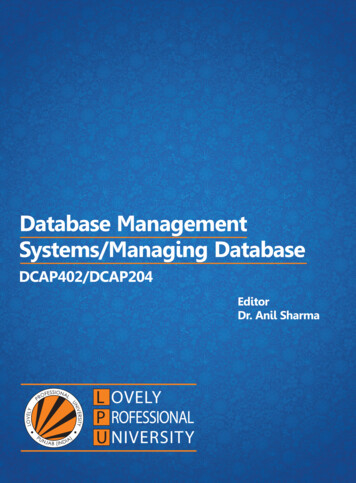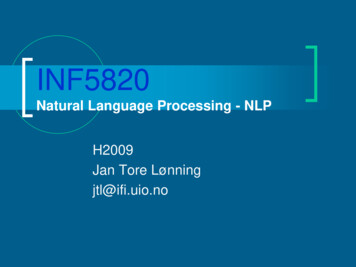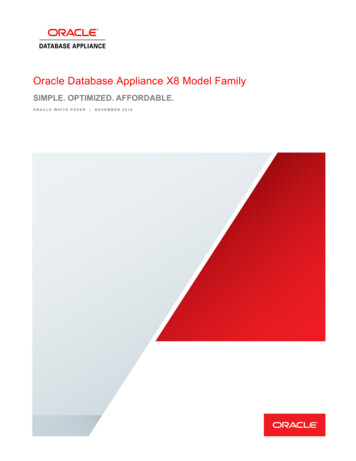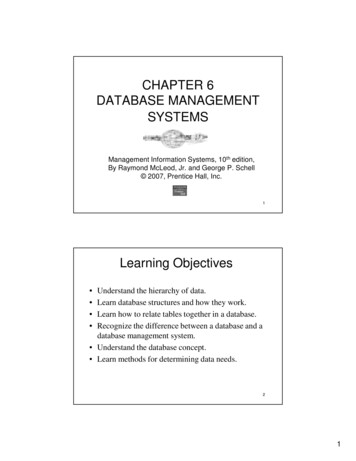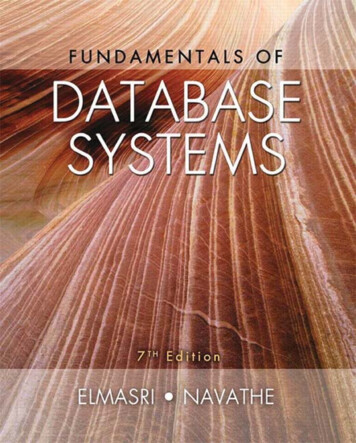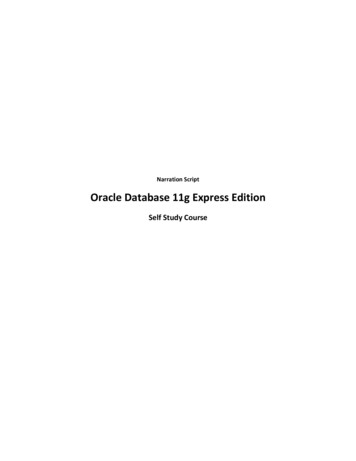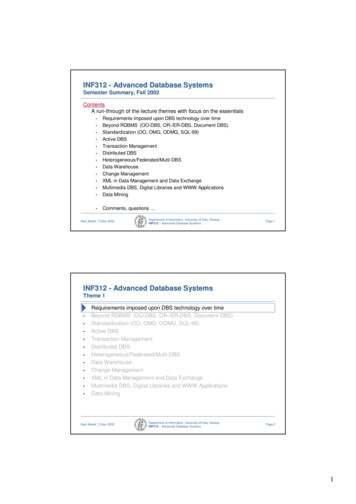
Transcription
INF312 - Advanced Database SystemsSemester Summary, Fall 2002ContentsA run-through of the lecture themes with focus on the essentials Requirements imposed upon DBS technology over timeBeyond RDBMS’ (OO-DBS, OR-/ER-DBS, Document DBS)Standardization (OO, OMG, ODMG, SQL-99)Active DBSTransaction ManagementDistributed DBSHeterogeneous/Federated/Multi-DBSData WarehouseChange ManagementXML in Data Management and Data ExchangeMultimedia DBS, Digital Libraries and WWW ApplicationsData Mining Comments, questions Naci Akkøk, 13.Nov.2002Department of Informatics, University of Oslo, NorwayINF312 – Advanced Database SystemsPage 1INF312 - Advanced Database SystemsTheme 1 Requirements imposed upon DBS technology over timeBeyond RDBMS’ (OO-DBS, OR-/ER-DBS, Document DBS)Standardization (OO, OMG, ODMG, SQL-99)Active DBSTransaction ManagementDistributed DBSHeterogeneous/Federated/Multi-DBSData WarehouseChange ManagementXML in Data Management and Data ExchangeMultimedia DBS, Digital Libraries and WWW ApplicationsData MiningNaci Akkøk, 13.Nov.2002Department of Informatics, University of Oslo, NorwayINF312 – Advanced Database SystemsPage 21
3-Step Historical ViewStorage, Retrieval and Exchange Technologies INF3/4180 Step 1: Own (separate) data management scheme for each application. Not feasible. Also commonalities discovered. Enter DBMS.Step 2: Lucky strike: Edgar F. Codd introduces and practically establishes therelational DB approach and relational algebra in one go (1970 - 74). Easy, formal and relationally complete. Addresses classical applications with classical requirements.Step 3: The OO paradigm is introduced (1967) and popularized (1989-90). New applications arise, imposing new requirements. RDBMS’ becomeinsufficient, too restrictive. No longer “data” but “objects” are stored, retrieved and exchanged.Department of Informatics, University of Oslo, NorwayINF312 – Advanced Database SystemsNaci Akkøk, 13.Nov.2002Page 33-Step ComparisonRequirements upon DBS’DBS’ of Classical and New ApplicationsRequirements Structures &OperationsClassical Simple, small & manyGenericNew Complex, large and fewUser-defined Transactions Small/simple objectsread/modified simply,short,concurrent but notcooperative Large/complex objectsprocessed complexly,long,concurrent and highlycooperative Integrityconstraints DB states consist of small &simple structures,State transitions via txs orgeneric operations,constraints on DB states DB states consist of large &complex structures,state transitions also viaarbitrary event sequences,arbitrary conditions on stateCommon Persistence management, consistency, ad-hoc queries, Naci Akkøk, 13.Nov.2002Department of Informatics, University of Oslo, NorwayINF312 – Advanced Database SystemsPage 42
3-Step Change in TechnologyRequirements upon DBS’DBS’ of the Technical Environment Technical environment: Non-stop improvement More power, more intelligence, more mobility, high cooperation etc.,encouraging complexity at application, service and base-system levels The Internet: A serious challenge and many possibilities Global, very high distribution/heterogeneity and need for integration,availability (7x24), scalability, security, . With respect to data/information and related operations: More readsthan writes, more search-dependent content, . Architecture: Implementing extensibility, scalability etc. From monolithic to component based (CB) architectures CB architecture advantages are obvious, but needs more coordination,management, standardization etc.Naci Akkøk, 13.Nov.2002Department of Informatics, University of Oslo, NorwayINF312 – Advanced Database SystemsPage 5INF312 - Advanced Database SystemsTheme 2 Requirements imposed upon DBS technology over timeBeyond RDBMS’ (OO-DBS, OR-/ER-DBS, Document DBS)Standardization (OO, OMG, ODMG, SQL-99)Active DBSTransaction ManagementDistributed DBSHeterogeneous/Federated/Multi-DBSData WarehouseChange ManagementXML in Data Management and Data ExchangeMultimedia DBS, Digital Libraries and WWW ApplicationsData MiningNaci Akkøk, 13.Nov.2002Department of Informatics, University of Oslo, NorwayINF312 – Advanced Database SystemsPage 63
Definition: Paradigm, ModelDBS Binoculars to Perceive and Model the World By The approach of choice by which the world is modeled is the “paradigm”Main Entry: par·a·digmPronunciation: 'par-&-"dIm also -"dimFunction: nounEtymology: Late Latin paradigma, from Greek paradeigma, from paradeiknynai to showside by side, from para- deiknynai to show -- more at DICTIONDate: 15th century1 : EXAMPLE, PATTERN; especially : an outstandingly clear or typical example orarchetype2 : an example of a conjugation or declension showing a word in all itsinflectional forms3 : a philosophical and theoretical framework of a scientific school or disciplinewithin which theories, laws, and generalizations and the experiments performed insupport of them are formulated- par·a·dig·mat·ic /"par-&-dig-'ma-tik/ adjective- par·a·dig·mat·i·cal·ly /-ti-k(&-)lE/ adverbfrom Merriam-Webster’son-line Collegiate Dictionary The capabilities as well as the limitations of a DBSis dictated by the paradigmNaci Akkøk, 13.Nov.2002Department of Informatics, University of Oslo, NorwayINF312 – Advanced Database SystemsPage 7Database SystemsAlternative DBS Paradigms (Models) File-based (files and -Oriented New/alternative transaction conceptsChange/version managementNew (data) models, formalisms, languagesNew, better and multi-paradigm DBManagement Systems (DBMS) Cross-breeds, Extensions and Persistence ServicesObject-Relational (or Extended Relational) Real-TimeMulti-Media Document-based Require Require Naci Akkøk, 13.Nov.2002 Heterogeneous/FederatedDBS, Multi-DBS Multiprocessor/ParallelDBS Expert Systems,Intelligent DBS,Semantic DBS,Active/Deductive DBS,Knowledge Base Systems Causal/Temporal DBS Extensible DBS Department of Informatics, University of Oslo, NorwayINF312 – Advanced Database SystemsPage 84
Database SystemsDefinition, Manipulation and Query LanguagesDEFINITIONDDL: Data Definition Language for defining data (schema).The CREATE sentence ODL: Object Definition Language, the OO counterpart for defining (declaring) objects(classes). ODL is the “schema” language of OO-DBS.MANIPULATION DML: Data Manipulation Language for processing/ transforming data.UPDATE, DELETE etc. sentences, GROUP BY etc. clauses.Not computationally complete. OML: Object Manipulation Language, the OO counterpart for manipulating objects.Programming language binding. Computationally complete.QUERY SQL is the name of one specific relational language incorporating data definition,manipulation and querying The querying part of SQL is represented by the SELECT sentence OQL: Object Query Language, the OO counterpart for querying for objects(collections of them) Naci Akkøk, 13.Nov.2002Department of Informatics, University of Oslo, NorwayINF312 – Advanced Database SystemsPage 9INF312 - Advanced Database SystemsTheme 3 Requirements imposed upon DBS technology over timeBeyond RDBMS’ (OO-DBS, OR-/ER-DBS, Document DBS)Standardization (OO, OMG, ODMG, SQL-99)Active DBSTransaction ManagementDistributed DBSHeterogeneous/Federated/Multi-DBSData WarehouseChange ManagementXML in Data Management and Data ExchangeMultimedia DBS, Digital Libraries and WWW ApplicationsData MiningNaci Akkøk, 13.Nov.2002Department of Informatics, University of Oslo, NorwayINF312 – Advanced Database SystemsPage 105
Object Management Group (OMG)The OO Bases of OOOO-DBS’DBS’ OMG – Existed before ODMG (Object Data Management Group).Standardized the Common Object Request Broker (CORBA) as well as IDLas part of the effort. See: http://www.omg.org/. IDL – Interface Definition Language. Basis for ODMG’s ODL. More recently Standardized UML (Unified Modeling Language), CWM (Common Warehouse Metamodel), MOF (Meta Object Facility), XMI (XML Metadata Interchange), and initiated the MDA (Model Driven Architecture) effort and some more (Persistent State Service). Has its “own” choice of object model that ODMG builds upon Naci Akkøk, 13.Nov.2002Department of Informatics, University of Oslo, NorwayINF312 – Advanced Database SystemsPage 11The OO ParadigmCentral OO Concepts #1The OO paradigm offers Classification – types/classes (user definable, nested); Conceptually withrespect to “classical” categorization theory (changing) Encapsulation – complete, write encapsulation and partial encapsulation Polymorphism – overloading/overriding, late bindingAll objects have Identity – permanent, immutable and non-reusable identity (OID) State – i.e., they “remember” through attributes (changing) Behavior – i.e., they “act” through methodsObjects associate with each other by Exchanging messages through a link between objects and via interfaces ofinvolved objects Inheritance – sub-tying/ super-typing, “IS A”; overriding Aggregation – composition, containmentNaci Akkøk, 13.Nov.2002Department of Informatics, University of Oslo, NorwayINF312 – Advanced Database SystemsPage 126
The OO ParadigmCentral OO Concepts #2 Literal – Is an object too, but without an OID: A structure for capturingcomplex values otherwise. Values and Equality – Same public values (shallow equality), same valuesregardless (deep equality), same object (equivalence, being “identical”). Collections – Was already around with Smalltalk (and later C ) beforeODMG. There are 5 of them: Set, Bag, List, Array, Dictionary. Usedextensively (also) in DBS, especially in managing data-sets (sets of objects) Intension and Extension – Intension is the definition (class, schema, in away “code template”) of all possible objects (instances), whereas extensionis the collection (set) of actual instances.Naci Akkøk, 13.Nov.2002Department of Informatics, University of Oslo, NorwayINF312 – Advanced Database SystemsPage 13Object Data Management Group (ODMG)Standardizing OOOO-DBS’DBS’ ODMG (@ Jan. 2000, v3.0) – Standards for storing (and retrieving) objects.See http://www.odmg.org/ ( ‘Standard Overview’ has a list of all standards)Object Management Architecture (OMA) and Object Data Model (buildsupon OMG’s Object Model) Object Specification Languages: Objects with OIDs and literals without, as beforeAn object’s attributes and relationships to other objects are properties that make up theobject’s state; Operations are properties as well, and make up the behavior of the object.Objects are instances of types within a super- and sub-type hierarchy; Type of object isknown at creation (and does not change); Multiple super-types are allowed, and super-typesmust be specified explicitly (can not be deduced through signature compatibility).Operations are defined on a single type, are invoked, may have side-effects and areimplemented by the methods of the type.NOT INCLUDED: Versions, realization/implementation standardization or specification,distributed systems, transaction mechanisms and other processing aspects, rules etc.ODL (Object Definition Language), based upon OMG’s IDLOIF (Object Interchange Format)OQL (Object Query Language), based upon SQL (as much as possible)Language Bindings: ODL, OML and OQL for C , Smalltalk and JavaNaci Akkøk, 13.Nov.2002Department of Informatics, University of Oslo, NorwayINF312 – Advanced Database SystemsPage 147
ObjectObject-Relational DBSSQLSQL-99 or SQLSQL-3 (SQL, ISO/IEC 90759075-n, 1999) ISO/IEC SQL 1999 standards are in many documents, and they cost.Go to http://www.iso.ch/iso/en/ISOOnline.frontpage and search for ‘SQL’and ‘standards’ to see a list of them (16 documents).SQL-99 attempts to address the same requirements that OO-DBS’ haveaimed at addressing, but based upon SQL instead (i.e., not from scratch)SQL-99 offers: Large objects (BLOBs and CLOBs)Richer types: New basic types, user defined types/ADTs, structured and reference types,distinct typesInheritance, overloading (overriding) of super-type methodsNested types (aggregates)Some amount of encapsulation (inclusion of ADT-methods)Collections and related operationsNew predicates (SIMILAR, UNIQUE, )Recursive queriesStandardized triggersImproved (and standardized) access control (DCL)Naci Akkøk, 13.Nov.2002Department of Informatics, University of Oslo, NorwayINF312 – Advanced Database SystemsPage 15XML and Document DBSSemiSemi-Structured Databases Based upon ISO-standard SGML. To understand the full implication of XML, see (atleast): http://www.w3.org/ (and click on XML), http://www.xml.org/, http://www.oasisopen.org/, http://www.hr-xml.org/channels/home.htm and others.Characteristics, advantages and uses With XML, one can define “document types” and schemas One can in principle “structure” data and tell the way it is structured also (metadata), making it ideal for describing and interchanging structured as well as semistructured data, including objects (where the object’s properties are the structure) Data can be stored as XML documents, DTD and XML Schema provide forschemas, there are a number of query languages and programming interfaces,but Lacks, disadvantages and misuses There is no data integrity, transactions, multi-user access (or access controlotherwise), security, indexing, queries across multiple documents XML is hierarchical (back to 60s and the hierarchical DBS) Far too much knowledge – also for constructing, storing and retrieving data – inthe application (almost back to square 1 of the DB era)Naci Akkøk, 13.Nov.2002Department of Informatics, University of Oslo, NorwayINF312 – Advanced Database SystemsPage 168
INF312 - Advanced Database SystemsTheme 4 Requirements imposed upon DBS technology over timeBeyond RDBMS’ (OO-DBS, OR-/ER-DBS, Document DBS)Standardization (OO, OMG, ODMG, SQL-99)Active DBSTransaction ManagementDistributed DBSHeterogeneous/Federated/Multi-DBSData WarehouseChange ManagementXML in Data Management and Data ExchangeMultimedia DBS, Digital Libraries and WWW ApplicationsData MiningNaci Akkøk, 13.Nov.2002Department of Informatics, University of Oslo, NorwayINF312 – Advanced Database SystemsPage 17Rules in DBSActive Database Systems What if we wanted to monitor the projects/resources database to check for arrival of unexpected (new) projects, and – if management approval and funding existed, hire in one or more consultants?EventConditionAction We could check manually at regular intervals, or write a program that pollsthe DB at regular intervals, or Acquire an Active DB:Implies writing in a “rule” that instructs a certain action to be triggered bysome event and if certain conditions hold. Remember: Event-Condition-Action (ECA) triplets make up the rules.Naci Akkøk, 13.Nov.2002Department of Informatics, University of Oslo, NorwayINF312 – Advanced Database SystemsPage 189
INF312 - Advanced Database SystemsTheme 5 Requirements imposed upon DBS technology over timeBeyond RDBMS’ (OO-DBS, OR-/ER-DBS, Document DBS)Standardization (OO, OMG, ODMG, SQL-99)Active DBSTransaction ManagementDistributed DBSHeterogeneous/Federated/Multi-DBSData WarehouseChange ManagementXML in Data Management and Data ExchangeMultimedia DBS, Digital Libraries and WWW ApplicationsData MiningNaci Akkøk, 13.Nov.2002Department of Informatics, University of Oslo, NorwayINF312 – Advanced Database SystemsPage 19Transaction ManagementFrom Classical to Modern Transactions ACID properties of “classical” transaction management: Atomic Indivisible between states (before/after transaction) Consistent Produce consistent results or abort Isolated As if all alone Durable Result is lasting once transaction is successful Classical transactions are typically short What happens if we have to deal with long transactions,and have to weaken some or all of the ACID requirements?Naci Akkøk, 13.Nov.2002Department of Informatics, University of Oslo, NorwayINF312 – Advanced Database SystemsPage 2010
Transaction ManagementOther (Modern) Transaction Types Flat TX with savepoints: Save, not commit. Controlled roll-back to anysaved point, but abort returns to starting state.Chained TX: Several sub-commits, roll-back/abort to last commit.Nested TX: TX within TX, functionally decomposed ClosedOpenMulti-Level TX: TX within TX, several pre-decided levels of abstractionUses compensation (not delete but cancel with a new cancel-TX)Distributed TX: Flat TX that runs on a distributed environmentLong TX: Mini-batch – TX split into shorter TX sequences under program control Sagas – Extended chains, uses compensation Cooperative TX – TXs co-operate to view each others’ partial results.Example: Check-in/Check-out ACCID: CC for Conditional Concurrency. Relaxes Conflict Serializability.APOTRAM.Naci Akkøk, 13.Nov.2002Department of Informatics, University of Oslo, NorwayINF312 – Advanced Database SystemsPage 21INF312 - Advanced Database SystemsTheme 6 Requirements imposed upon DBS technology over timeBeyond RDBMS’ (OO-DBS, OR-/ER-DBS, Document DBS)Standardization (OO, OMG, ODMG, SQL-99)Active DBSTransaction ManagementDistributed DBSHeterogeneous/Federated/Multi-DBSData WarehouseChange ManagementXML in Data Management and Data ExchangeMultimedia DBS, Digital Libraries and WWW ApplicationsData MiningNaci Akkøk, 13.Nov.2002Department of Informatics, University of Oslo, NorwayINF312 – Advanced Database SystemsPage 2211
Distributed DBSDistributing the Processed and the Processing Distribution offers enhanced performance, more data volume &extensibility/scalability Ask yourself:What is it that can be/should be distributed?Data? Processing of data? Both? Data distributed:Distinct “rows” of same “table” across the network? Distinct“columns” of same “table”? Same data replicated?Processing distributed:Logging/recovery, locking/concurrency control, transactionmanagement, sorting/indexing, access control, cache/buffermanagement? Application-controlled processing of data? All?Parts of DB management can and should also be distributed Parts may need to stay centralized.Naci Akkøk, 13.Nov.2002Department of Informatics, University of Oslo, NorwayINF312 – Advanced Database SystemsPage 23Distributed DBSThree ClientClient-Server Architectures Three C/S architecture alternatives:Object Server, Page Server, File ServerPage & File ServerObject ServerSimple server designComplex client designFine-grained concurrency controldifficultVery sensitive to client buffer poolsizeVery sensitive to clusteringComplex server designSimpler client designFine-grained concurrency controlfeasibleLess sensitive to client buffer poolsizeReduces data movement,relatively insensitive to clusteringNaci Akkøk, 13.Nov.2002Department of Informatics, University of Oslo, NorwayINF312 – Advanced Database SystemsPage 2412
Distributed DBSProblem Areas Distributed DB design Distributed directory/catalogue management Distributed query processing and optimization Distributed transaction management Distributed concurrency control Distributed deadlock management Distributed recovery management Remember quorums! Coordinator coordinated majority votes. Used in concurrency control, commit/abort, termination and recoveryprotocols.Naci Akkøk, 13.Nov.2002Department of Informatics, University of Oslo, NorwayINF312 – Advanced Database SystemsPage 25INF312 - Advanced Database SystemsTheme 7 Requirements imposed upon DBS technology over timeBeyond RDBMS’ (OO-DBS, OR-/ER-DBS, Document DBS)Standardization (OO, OMG, ODMG, SQL-99)Active DBSTransaction ManagementDistributed DBSHeterogeneous/Federated/Multi-DBSData WarehouseChange ManagementXML in Data Management and Data ExchangeMultimedia DBS, Digital Libraries and WWW ApplicationsData MiningNaci Akkøk, 13.Nov.2002Department of Informatics, University of Oslo, NorwayINF312 – Advanced Database SystemsPage 2613
ulti/Multi-DBSThe Need and the SolutionGlobalApplicationHDBSMeta-DataExport Schema 1 GlobalApplicationHDBSINTEGRATION LAYERDBS 1DBS 2 DBS nDB 1DB 2 DB nLocalApplicationExport Schema 2Export Schema nNaci Akkøk, 13.Nov.2002Department of Informatics, University of Oslo, NorwayINF312 – Advanced Database SystemsPage /Multi/Multi-DBSWhat Does (Should) the Integration Layer Provide? Global data-modelGlobal schema and meta-data managementGlobal, distributed transaction managementGlobal, consistent recoverySupport for global/distributed DDL, DML, and DQL, of course (distributed/global query processing/optimization)Distribution transparency (transparent integration of the DBSs/DBAs)ExtensibilityTools, techniques (always forgotten), for example for (local) schemahomogenization, export/integration and global schema constructionNaci Akkøk, 13.Nov.2002Department of Informatics, University of Oslo, NorwayINF312 – Advanced Database SystemsPage 2814
INF312 - Advanced Database SystemsTheme 8 Requirements imposed upon DBS technology over timeBeyond RDBMS’ (OO-DBS, OR-/ER-DBS, Document DBS)Standardization (OO, OMG, ODMG, SQL-99)Active DBSTransaction ManagementDistributed DBSHeterogeneous/Federated/Multi-DBSData WarehouseChange ManagementXML in Data Management and Data ExchangeMultimedia DBS, Digital Libraries and WWW ApplicationsData MiningDepartment of Informatics, University of Oslo, NorwayINF312 – Advanced Database SystemsNaci Akkøk, 13.Nov.2002Page 29Data WarehouseThe Value and Whereabouts of Information in Data Large DB, storing (tera-bytes of mostly static) data from multiple sourcesFor generating information, i.e., for Decision Support, On-Line Analytical Processing,Summary Table(data-cube, multi-dim.) Data Mining etc.Dimension TableGlobal SchemaDefinition & Design4-StepLife CycleFact Table(attr. of one dim. of FT)(timed for validity)DataExtraction & LoadingExtract & clean data, materialize views andmeasures, store in DWQuery ProcessingRoll-up, Drill-down, Pivot/Rotate,Slice/Dice with Data-BladeSort, Select, Derive (attributes/new queries)Data UpdateMonitor/track data sources, refresh DW(creating diffs & deltas)Naci Akkøk, 13.Nov.2002Department of Informatics, University of Oslo, NorwayINF312 – Advanced Database SystemsPage 3015
INF312 - Advanced Database SystemsTheme 9 Requirements imposed upon DBS technology over timeBeyond RDBMS’ (OO-DBS, OR-/ER-DBS, Document DBS)Standardization (OO, OMG, ODMG, SQL-99)Active DBSTransaction ManagementDistributed DBSHeterogeneous/Federated/Multi-DBSData WarehouseChange ManagementXML in Data Management and Data ExchangeMultimedia DBS, Digital Libraries and WWW ApplicationsData MiningNaci Akkøk, 13.Nov.2002Department of Informatics, University of Oslo, NorwayINF312 – Advanced Database SystemsPage 31Change ManagementA World in Parts, Versions and Configurations Objects, parts, schema are versioned, either because different configurations are required, or because of collaborative work, where access to same object/part isnecessary or because of the need for modifications/evolutions (for example onschema) while ensuring “backwards compatibility”Workspaces are (often individual) areas for keeping ‘own’ copies/versions(usually ‘checked-out’ prior to work, and ‘checked-in’ after work)A configuration is selection of constituent versioned objects/partsOther kinds of versions: Revisions, alternatives, variants, representations(equivalences)Conflict resolution, for example on merging different versions of same object(for example due to parallel modifications on the same object)Naci Akkøk, 13.Nov.2002Department of Informatics, University of Oslo, NorwayINF312 – Advanced Database SystemsPage 3216
INF312 - Advanced Database SystemsTheme 10 Requirements imposed upon DBS technology over timeBeyond RDBMS’ (OO-DBS, OR-/ER-DBS, Document DBS)Standardization (OO, OMG, ODMG, SQL-99)Active DBSTransaction ManagementDistributed DBSHeterogeneous/Federated/Multi-DBSData WarehouseChange ManagementXML in Data Management and Data ExchangeMultimedia DBS, Digital Libraries and WWW ApplicationsData MiningDepartment of Informatics, University of Oslo, NorwayINF312 – Advanced Database SystemsNaci Akkøk, 13.Nov.2002Page 33XML in Data Management and Data ExchangeThe Conveyor Belt of Data in the WWW Age Allows for interchange and interpretation of structured and semi-structureddataXMI (XML Metadata Interchange adopted by OMG) is one exampleNote: Remember the concept of a “namespace” XML is hierarchical See XML in theme 3, “XML and Document DBS”, slide 16 Naci Akkøk, 13.Nov.2002 Department of Informatics, University of Oslo, NorwayINF312 – Advanced Database SystemsPage 3417
INF312 - Advanced Database SystemsTheme 11 Requirements imposed upon DBS technology over timeBeyond RDBMS’ (OO-DBS, OR-/ER-DBS, Document DBS)Standardization (OO, OMG, ODMG, SQL-99)Active DBSTransaction ManagementDistributed DBSHeterogeneous/Federated/Multi-DBSData WarehouseChange ManagementXML in Data Management and Data ExchangeMultimedia DBS, Digital Libraries and WWW ApplicationsData MiningNaci Akkøk, 13.Nov.2002Department of Informatics, University of Oslo, NorwayINF312 – Advanced Database SystemsPage 35Multimedia DBS ( Digital Libraries and the WWW)The Art of Exact Copying The major issue in multimedia (for example in transmitting MM data) is theissue of copying the source to the destination as truthfully as possible, whilemaintaining full control of the data so as to be able to manipulate the data invarious waysMMDBS offers (or should offer) support for: “Almost” real-time storage/retrieval and processing Temporal concepts Representing and processing various data types uniformly Representing and processing large amounts of data uniformly Managing various data storage devices/units, tertiary storage, multilevel storage uniformly Abstract operations on MM data Storage and processing parallelism Distribution/synchronizationNaci Akkøk, 13.Nov.2002Department of Informatics, University of Oslo, NorwayINF312 – Advanced Database SystemsPage 3618
INF312 - Advanced Database SystemsTheme 12 Requirements imposed upon DBS technology over timeBeyond RDBMS’ (OO-DBS, OR-/ER-DBS, Document DBS)Standardization (OO, OMG, ODMG, SQL-99)Active DBSTransaction ManagementDistributed DBSHeterogeneous/Federated/Multi-DBSData WarehouseChange ManagementXML in Data Management and Data ExchangeMultimedia DBS, Digital Libraries and WWW ApplicationsData MiningNaci Akkøk, 13.Nov.2002Department of Informatics, University of Oslo, NorwayINF312 – Advanced Database SystemsPage 37Data MiningQuerying for What You Don’Don’t Know is There Extraction/discovery of potentially useful (implicit) information form existingdata (for example from a Data Warehouse): Knowledge Discovery inDatabases (KDD)OLAP: On-Line Analytical Processing (estimation/planning, discovery ofmulti-dimensional data relationships)Data mining techniques require a good mastery of statistical/analyticaltechniques (statistical/mathematical modeling and a good deal of AItechniques) Neural Networks, Training & Mining, Genetic Algorithms, BayesianStatistics, Regression Analysis, Pattern Discovery .DBS support is as for a “Programmable Data Warehouse”See also theme 8, Data Warehouse, slide 30Naci Akkøk, 13.Nov.2002Department of Informatics, University of Oslo, NorwayINF312 – Advanced Database SystemsPage 3819
INF312 - Advanced Database SystemsTheme 12 Requirements imposed upon DBS technology over timeBeyond RDBMS’ (OO-DBS, OR-/ER-DBS, Document DBS)Standardization (OO, OMG, ODMG, SQL-99)Active DBSTransaction ManagementDistributed DBSHeterogeneous/Federated/Multi-DBSData WarehouseChange ManagementXML in Data Management and Data ExchangeMultimedia DBS, Digital Libraries and WWW ApplicationsData Mining Comments, questions. Naci Akkøk, 13.Nov.2002Department of Informatics, University of Oslo, NorwayINF312 – Advanced Database SystemsPage 39CommentsOn Exam Style List up and then explain!Stay in dialogue!Draw, demonstrate! And good luck! Questions ? Naci Akkøk, 13.Nov.2002Department of Informatics, University of Oslo, NorwayINF312 – Advanced Database SystemsPage 4020
INF312 - Advanced Database Systems Database Systems Definition, Manipulation and Query Languages DDL: Data Definition Language for defining data (schema). The CREATE sentence ODL: Object Definition Language, the OO counterpart for defining (declaring) objects (classes). ODL is the "schema" language of OO-DBS.

